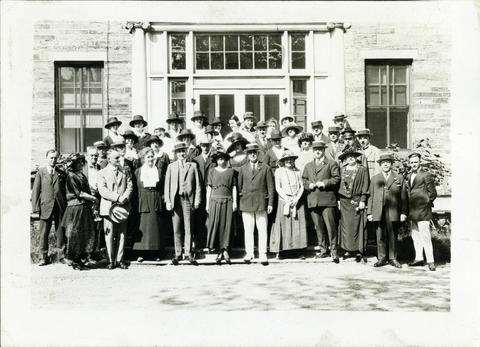
The Massachusetts-Halifax Relief Commission Public Health Unit
By Lisa McNiven, Collections Assistant,
Naval Museum of Halifax
Stadacona has a long tradition of supporting naval families. One of the lesser known chapters in this rich history is that of Admiralty House. This house has served many purposes during its 200 years; built to be the headquarters for the Commander-in-Chief of the Royal Navy’s North Atlantic station, it was a Wardroom Officers’ Mess, and is now the Naval Museum of Halifax. One of its lesser known roles was to serve as a Naval Hospital and community clinic.
The first naval medical unit in the house opened during the summer of 1917. The Halifax Explosion on December 6, 1917, ensured this hospital was short lived due to significant damage to the building. The House was damaged in the explosion but was resurrected in another medical capacity in 1920. With resources stretched thin, the Public Works Department of Halifax requested that the RCN assist in supporting the local families in the neighborhood who were still recovering and rebuilding from the destruction. The Admiralty gave permission for Admiralty House and its grounds to be used as the Massachusetts-Halifax Relief Commission Public Health Unit No.1 public health unit.
Operating from May 1920 to 1924, the purpose of the clinic was to improve the standard of living and health for the North end community. According to the Halifax Relief Committee, it was an ideal location given the House’s previous history as a hospital, and the grounds that could be used as a community garden to grow fresh vegetables and encourage healthy nutrition. “It was convenient of access to families who had suffered most in the disaster and were in most in need of its service. It was an ideal center also, because of its location in that part of the city where nearly half of the city’s babies were born.”
The Clinic opened with a staff of 13 Public Health nurses, 18 doctors and support staff. Among the staff was Dalhousie’s first female dental graduate, Dr. Arabelle MacKenzie. She worked as a pediatric dentist in the house and during that time met Dr. MacCallum, after whom the MacCallum Health Clinic building is named). The hospital ran six days a week with services for pediatric care, tuberculosis screening, pre-school dental, posture and a prenatal and baby welfare clinic. There was a temporary ward for the removal of tonsils and adenoids. In four years the hospital carried out 257,967 clinical treatments and outreach visits. In addition to providing medical services, the clinic hosted mother and baby socials and shared education resources such as nutrition classes with an emphasis on healthy eating. The Commission encouraged the community to participate in these activities. “In the spring of 1920, the garden (on Admiralty House property) was divided into plots and apportioned to some 30 families possessing no yard of their own. This plan has been carried out with great success each year.” The clinic was eventually incorporated into the Dalhousie Health Services.
During the Second World War, sudden growth and overcrowding in Halifax created a need for family support and demand for public health clinics rose again. A joint project by the Halifax Medical Society, the Dalhousie Health Clinic and the RCN opened sometime after 1941.
Known as the RCN Well Baby Health Service, it was formed as a support for families of sailors. It consisted of three Canadian naval and naval volunteer reserve doctors who carried out the project along with Nursing Sister Elaine Ambery. A newspaper article written after 1941, celebrates the process of keeping children of the RCN healthy, noting that “the clearing up of general baby problems and the prevention of immunizable infectious diseases will prove a great boon.” The conclusion of the article states that both naval wives and women of the community were needed to make the program work and the program proved successful.
After 1942, a Well Baby Clinic was established at Stadacona. According to a base inventory of housing units, a 1,500 square foot clinic was established near the R.C.N. hospital. The clinic had evolved from a once a week, appointment based service to a four-day a week clinic and day nursery. “Twice a week this building is open as a baby clinic, where mothers can get advice on feeding, inoculations, etc., while on two other days throughout the week it functions as a day nursery, where mothers may leave their children while they for shopping.” The clinic continued until at least 1963 with Nursing Sister Ambery still on site, conducting home visits and check-ups. A newspaper article in 1963, lists the continued services and the names of volunteers who worked at the clinic.






